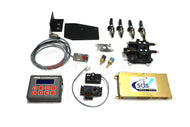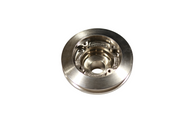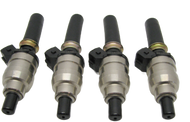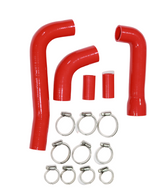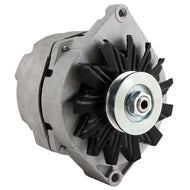The information here is good to read if you are considering supercharging your vehicle. We DO NOT sell Magnuson Supercharger kits. This is purely a business decision and not related in any way to the quality or value of this product. We simply go another direction and focus on the kits we build in house for Alfa Romeos. I have this page here strictly for informational purposes.
For more in-depth information, please consider reading Greg's book on supercharging.
Why supercharging? Because supercharging is the best way to get a big increase in power. The days of being able to increase compression, add a set of headers, and bolt on a 4 barrel carburetor to get a big increase in power are over. That worked very well at one time. However, modern cars already have high compression, pretty good exhaust manifolds, aggressive cams, and very effective fuel injection systems. There is very little room for improvement with conventional mods on a car that needs to be street-able.
A modern Roots supercharger will add 30%-65% more horsepower throughout the RPM range. Conventional modifications can't come anywhere close. Lets compare compare real numbers. For example I will use a 2003 Chevrolet Silverado Pickup.
Start with a K&N intake, (I will use Summit's prices rounded to the nearest dollar) it's $300, part number KNN-57-3038. Next we will need headers. Borla's stuff is OEM quality and proven to work well, their headers are $768 part number BOR-17110. Add Borla's excellent dual exhaust for $836 part number BOR 14940. Next you will need a performance tuner, let's use Crane's Power Max tuner, part number CRN-1202-003, it's $430. All this adds up to $2,334. Of course I could have skimped a little here and there, but a lot of the cheaper products actually cause a loss of horsepower. K&N, Borla, and Crane's products are not the cheapest but they are quality brands proven to perform.
There won't be any horsepower guarantees with these products but I figure best case you will have about a 40 horsepower gain with this combination, and most of this increase would only be at very high RPM where you don't spend a lot of time.
Now lets compare this to a Supercharger kit. This kit can be found as low as $3495. A 2003 6 liter Silverado puts out 345 horsepower stock. The least any Supercharger kit will give you is a 30% increase in horsepower. That means at least 449 horsepower for a gain of 104 horsepower. Plus unlike the conventional modifications, the supercharged engine will provide a great increase in power from right off idle all the way up to redline.
The conventional modifications cost about $58 per horsepower, the supercharger kit's horsepower cost under $34 per horsepower. The supercharger kit provides far more power, especially down in the low and mid range area where you can really use it. Keep in mind, I am probably understating the gains with the supercharger kit and overstating them for the conventional modifications.
Ok, so supercharging gives more power and more power per dollar, but... Why buy a Magnuson supercharger kit? There are many other brands, Vortech, ATI, etc. Some claim even higher power gains. Warning! This next section is quite long. It takes a lot of text to explain this properly. It's also important to remember that this entire discussion is in the context of the engines we deal with. There are some generalizations that don't apply to two strokes, Diesels, Nitromethane burning dunebuggys, etc.
To explain this I first need to explain the various methods of supercharging. All methods of supercharging do basically the same thing. They force more air into the engine than it could inhale by itself. This allows the engine to burn more fuel at full throttle and thus make more horsepower. However, just how more air is forced in varies quite a bit. The following methods of supercharging are commonly used.
1. The Roots supercharger. This is a belt driven pump which has intermeshing lobes which force air into the engine. The Magnuson Supercharger is a modern version of the Roots supercharger. It has various improvements to make it more efficient. These improvements include three intermeshing lobes per rotor instead of two, and the rotors are twisted 60 degrees to form a helix. The port geometry is also greatly improved over traditional Roots supercharger. Magnuson is the primary manufacturer of modern Roots supercharger kits.
Pictured Below is a modern Roots Supercharger. Over 300,000 factory vehicles roll off the assembly lines each year with this type of supercharger.

2. Lysholm Screw Type supercharger. This type of supercharger is very similar to the Roots type. Instead of intermeshing lobes it has big intermeshing screws. Externally it looks just like a Roots supercharger. It has some advantages and some disadvantages when compared to the modern Roots supercharger which I will be discussing. A few companies use this type, including Whipple, Autorotor, IHI, and some others.
3. The Turbocharger. The Turbocharger, often called a Turbo, and originally called a Turbosupercharger, is an exhaust driven compressor. It uses exhaust energy to spin a compressor to incredibly high RPM (about 2000 revolutions per second!) which forces air into the engine. It's compressor section looks nothing like a Roots or Lysholm unit, it's more like a centrifugal fan in a modern hair dryer. Garret and IHI are the most common turbocharger manufacturers.
A Turbocharger

4. The Centrifugal supercharger. This is sort of a hybrid device. It uses a centrifugal compressor almost exactly like a turbocharger, however it's driven by a belt, not exhaust. Centrifugal supercharger kit makers include Vortech, ATI, Powerdyne and a few others. Quite a few companies make centrifugal superchargers, including, Vortech, Powerdyne, ATI, Rotrex, Paxton, and more.
Each of these systems offers some advantage over the other. Each has its strong points and it's weak points. Here they are:
Roots: OK, we are talking about the MODERN Roots supercharger. A lot of vendors of other types like to compare using efficiency numbers from ancient GMC blowers. The modern Roots supercharger has a few big advantages. First, it's the only style that compresses the air outside the unit itself. This means that when its bypass valve is open (standard equipment on all Magnuson kits) it's basically shut off. This means that any adverse effects on fuel economy or emissions during normal driving are negligible. Second, below 10 pounds of boost its efficiency numbers (i.e. power required to drive the supercharger itself and the discharge air temperatures) are really tough to beat. Third is reliability - the Magnuson supercharger requires almost zero maintenance. It only needs an oil change once every 100,000 miles and that's it! It has it's own reservoir so it doesn't heat up the engine oil. Fourth and perhaps most important is power - the Roots type supercharger puts out a lot of power at ALL RPM. Right off idle an engine with a Roots supercharger will typically have nearly full boost and massive power. This power increase will be fairly constant throughout the RPM range.
Lysholm: The Lysholm unit is very comparable to the Roots in most ways. It provides full boost from low RPM. Above 10 pounds of boost it's more efficient than the Roots blower, meaning it has lower discharge temperatures and uses less power to drive it. From a pure horsepower standpoint, above 10 pounds of boost the Lysholm is superior. From an "I actually plan to drive this car on the street point of view" it's not quite as good. The Lysholm has a few weaknesses. First, most street supercharger kits run 8 pounds of boost or less so unless you are talking about a custom built engine with low compression pistons, or you are willing to burn racing fuel, the Lysholm's high boost advantages are lost. The second weakness is that it compresses air internally. That means that a bypass valve can not fully shut it off. The result is your engine burns extra fuel to drive the supercharger at all times, even if you don't need the power. This also means that the supercharger is heating things up all the time which can result in a heat soaked intercooler, totally defeating the lower discharge temps. The fact that it can't be shut off with a bypass valve is the main reason the Lysholm design is not the design of choice among major auto manufacturers. It's worth noting that some attempts at shutting it off with an electronic clutch have been made, none have been successful in aftermarket applications.
The Turbocharger: Turbochargers, correctly called turbo superchargers are exhaust driven superchargers. I think the turbocharger is the most misunderstood form of forced induction. They are often assumed to have advantages in efficiency they just don't have, and strangely they are rarely credited for the advantages they do have.
The turbo charger has one big advantage over all belt driven superchargers. Do you know what it is? I'll bet you don't because it's almost never mentioned. It's the ability to vary its RPM independently of engine speed. This enables it to maintain its target boost levels under a wide variety of conditions. For example: on a day with low atmospheric pressure a belt driven supercharger will put out a little less boost than on a normal day; the Turbocharger will maintain normal boost by spinning a little faster. At high altitude the Turbo can maintain normal boost levels automatically where a belt driven unit would need a pulley change to maintain boost. (This advantage is entirely negated in the United States because at high altitude 93 octane fuel in not available requiring the use of lower boost anyway. If the turbo runs sea level boost at altitude the ignition computer will just retard timing to control detonation, thus reducing power.)
The second advantage is that the Turbocharger's centrifugal compressor is very efficient at high rpm and high boost levels. In an apples to apples comparison on an engine with 20 pounds of boost a turbocharger will give more horsepower than any other form of forced induction. However, the reality is that most street supercharger and turbo kits are limited to about 5-8 pounds of boost do to engine and driveline limitations. Down at these real world boost levels the turbo's compressor advantages are lost.
The turbocharger has a number of drawbacks. At lower boost levels it's not that efficient. In fact under 8 pounds of boost it generally cost more to drive a turbo due to exhaust backpressure than it does to drive a Roots supercharger. Yes, it's true, the story that a turbocharger is driven from "free" or "wasted" energy is a total myth. Exhaust backpressure costs power just like a belt does. The turbochargers drawbacks are many. First of all, there is lag. This problem has been greatly reduced but it's still there. Next, there is the lack of power down at low rpm. Until the engine is putting out enough exhaust to spin up the turbo, it's not going to deliver much boost. Next is reliability. The turbocharger uses engine oil which it heats up. The extra exhaust back pressure is very hard on the exhaust valve guides often leading to accelerated wear. Turbos have improved greatly over the years, but I have yet to drive one that doesn't have some lag and isn't weak below 2500 RPM. Combine that with the shorter engine life ( do you know of an aftermarket Turbo kit that offers a powertrain warranty? No you don't ) and the fact that at streetable boost levels there is no performance gain and it becomes difficult to make a good argument for a turbo kit.
Centrifugal Superchargers: Let's get one thing straight: NOBODY has built a factory supercharged car using one of these things since the 1960's, and every company I know of that did it back then is now out of business. Why is that? Because while the centrifugal units are great for certain applications they are poor performers on street cars. Here is the main problem: As with any centrifugal pump, output increases exponentially with speed measured in RPM. In other words when set up for 8 pounds of boost (about all you can run safely on a modern engine with pump gas) on an engine with a 6000 RPM redline they will only provide 2.8 pounds of boost at 3000 RPM. Now for some real math. With 8 pounds of boost at 6000 RPM an engine will gain about 54% more power. With 2.8 pounds the power gain will be only 19% at 3000 RPM. Obviously below 3000 rpm the power gains would be insignificant. Take a look at your tach when driving on the street and see where you are really operating the engine. It's rarely in the range where the Centrifugal will be giving a lot of boost. With the same 8 pounds of boost all the other types would be giving the nearly the full 54% increase through the whole RPM range. The Centrifugal units do have some advantages. First they cost less power to drive than all other belt driven types. They also have lower discharge temps. This means that at 6000 RPM with 8 pounds of boost and everything else equal they will put out slightly more horsepower. The problem is that in a race by the time they reach 6000 RPM the cars with Roots, Lysholms, or Turbos will be long gone. The other big advantage is that it's A LOT easier to make a kit using a centrifugal unit. I know, I make custom supercharger kits! They have lots of fittings for easy remote mounting and they have round intake and discharge ports which are easy to attach tubing too. With Roots or Lysholms there is A LOT more stuff to be manufactured. The commercial success of Centrifugal superchargers is due to two factors: it's a lot easier to make the kits, and they can advertise a higher peak horsepower number which is all the uneducated buyer looks at. The reality is the lack of power throughout the RPM range means you get beat by every other supercharged car on the road.
Now I may seem a bit negative about the Centrifugal units and I don't really mean to be. For certain applications they are great. For example: if you are building a 2000 horsepower car set up for drag racing with closely spaced gears, a Centrifugal unit just might be the way to go. This is because the car will be traction limited at the low and mid range end of low gear so the lack of boost is not a factor. Once the car gets going the closely spaced gears enable the engine to stay right in the range where it makes power. If you are going to set a car up this way the ATI Procharger is probably the way to go. The car will make more power than any other belt driven system and not have the spooling up issues of a turbocharger.
In Summary here are the advantage of the Roots supercharger
VS Lysholm the Roots offers better fuel economy and better performance at the boost levels you are likely to use. Plus it offers reliability proven in over 300,000 factory applications a year.
VS Turbos the Roots offers more power under the curve and probably more power period below 8 pounds of boost. The Roots supercharger has no lag, and a lot more power at low RPM. The Roots also has the edge in reliability. As I said, try and find an aftermarket Turbo kit with a 3 year warranty, or any powertrain warranty at all!
VS Centrifugals. This one is easy. A lot more power under the curve (that means throughout the RPM range) and proven reliability.
For a street car, the Roots supercharger is simply the best way to go. I am sure there are some who will disagree but consider that G.M., Ford, Mercedes, Aston Martin, Mini and others came to the same conclusion as a result of their own research
Read more in the Forced Induction Myths page.
For even more in-depth information, please consider reading Greg's book on supercharging.

